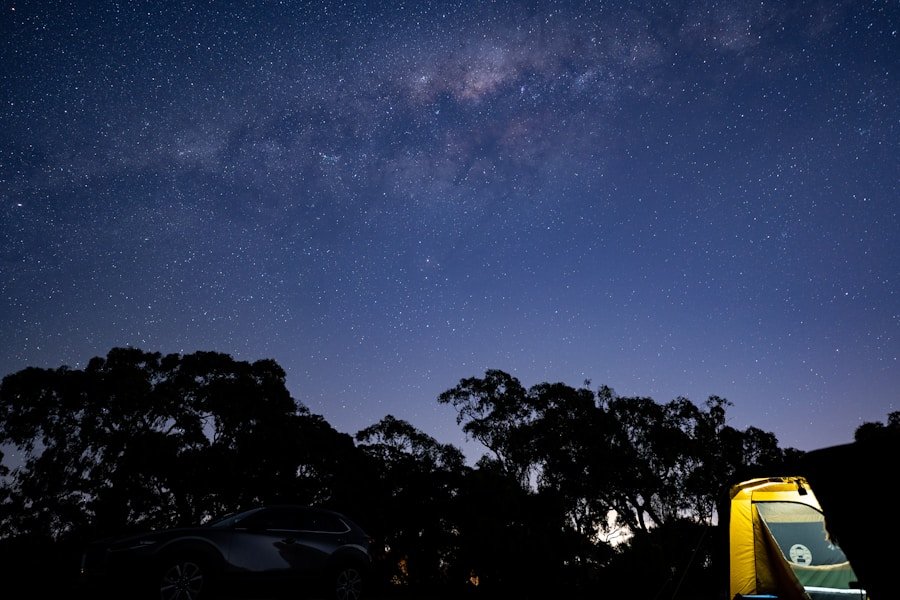Hammocks have become increasingly popular among campers for a variety of reasons. One of the main benefits of using a hammock for camping is the comfort it provides. Unlike sleeping on the hard ground in a tent, hammocks allow campers to sleep in a suspended position, which can alleviate pressure points and provide a more restful night’s sleep.
Additionally, hammocks are lightweight and easy to pack, making them a convenient option for backpackers and hikers who need to carry their gear over long distances. Another benefit of using a hammock for camping is the versatility it offers. Hammocks can be set up in a variety of locations, including rocky or uneven terrain where tents may not be suitable.
This allows campers to find the perfect spot to set up camp, even in challenging environments. Additionally, hammocks can be used as a comfortable place to relax during the day, providing a comfortable and elevated seating option for campers to enjoy the great outdoors.
Key Takeaways
- Hammocks provide a comfortable and versatile sleeping option for campers, offering a lightweight and compact alternative to traditional tents.
- Hammocks can enhance the outdoor experience by allowing campers to sleep closer to nature, enjoy better views, and avoid uneven or wet ground.
- When choosing a hammock for camping, consider factors such as weight capacity, material, insulation, and additional features like bug nets and rain flies.
- Setting up and using a hammock while camping requires proper knowledge of knot tying, tree selection, and suspension systems to ensure safety and comfort.
- Hammock camping has a lower environmental impact than traditional tent camping, as it minimizes ground disturbance and reduces the need for heavy gear.
How Hammocks Enhance the Outdoor Experience
Hammocks have the ability to enhance the outdoor experience in a number of ways. Firstly, they provide a unique and immersive way to connect with nature. By sleeping in a hammock, campers are able to experience the sights and sounds of the natural world in a way that is not possible when sleeping in a traditional tent.
The gentle rocking motion of a hammock can also provide a soothing and calming effect, helping campers to relax and unwind after a day of outdoor activities. Additionally, hammocks can provide a sense of freedom and adventure that is unmatched by traditional camping methods. The ability to set up camp in unconventional locations, such as between trees or on the edge of a cliff, allows campers to experience the great outdoors in a whole new way.
This sense of adventure can add an extra level of excitement to any camping trip, making it a truly memorable experience for all involved.
Choosing the Right Hammock for Your Camping Trip
When it comes to choosing the right hammock for your camping trip, there are a few key factors to consider. Firstly, it’s important to think about the size and weight of the hammock. For backpackers and hikers, a lightweight and compact hammock is essential, as it will need to be carried over long distances.
Additionally, the size of the hammock should be large enough to provide a comfortable sleeping space, but not so large that it becomes cumbersome to carry. Another important consideration when choosing a hammock for camping is the material it is made from. Nylon hammocks are lightweight and quick-drying, making them a popular choice for outdoor enthusiasts.
However, some campers may prefer the comfort and breathability of a cotton hammock. Ultimately, the best choice will depend on individual preferences and the specific needs of the camping trip.
Tips for Setting Up and Using a Hammock While Camping
| Benefits of Hammocks for Campers | Reasons |
|---|---|
| Comfort | Provides a comfortable and relaxing place to rest and sleep |
| Portability | Lightweight and easy to carry, perfect for backpacking and hiking |
| Versatility | Can be set up in various locations, including forests, beaches, and mountains |
| Protection | Elevated position keeps campers away from insects, damp ground, and small animals |
| Connection with Nature | Allows campers to sleep under the stars and feel closer to nature |
Setting up and using a hammock while camping may seem daunting at first, but with a few tips and tricks, it can be a simple and enjoyable experience. Firstly, it’s important to find two sturdy anchor points from which to hang the hammock. Trees are often the best option, but it’s important to ensure that they are healthy and strong enough to support the weight of the hammock and camper.
Once the anchor points have been identified, it’s time to set up the hammock. Most modern hammocks come with easy-to-use suspension systems that make set-up a breeze. However, it’s important to ensure that the hammock is hung at an appropriate height and angle to provide a comfortable sleeping position.
Additionally, using a tarp or rainfly can help protect the hammock from the elements and provide extra insulation during colder nights.
Hammock Camping: A Lightweight and Versatile Alternative to Tents
Hammock camping offers a lightweight and versatile alternative to traditional tent camping. Unlike tents, which require flat and level ground for set-up, hammocks can be used in a variety of terrains, including rocky or sloped surfaces. This makes them an ideal option for campers who enjoy exploring remote or challenging environments.
Additionally, hammocks are much lighter and more compact than tents, making them an excellent choice for backpackers and hikers who need to carry their gear over long distances. This lightweight design also makes them easier to set up and take down, allowing campers to spend more time enjoying the great outdoors and less time dealing with complicated gear.
The Environmental Impact of Hammock Camping
Hammock camping can have a lower environmental impact than traditional tent camping in several ways. Firstly, because hammocks do not require flat and level ground for set-up, they can be used in areas where tents may cause damage to fragile ecosystems. This allows campers to minimize their impact on the environment while still enjoying the great outdoors.
Additionally, hammocks are often made from lightweight and durable materials that have a smaller carbon footprint than traditional tent materials. This means that choosing a hammock for camping can be a more eco-friendly option for outdoor enthusiasts who are conscious of their environmental impact.
Safety Considerations for Hammock Camping
While hammock camping can be a safe and enjoyable experience, there are some important safety considerations to keep in mind. Firstly, it’s essential to ensure that the anchor points used to hang the hammock are strong and secure. This will help prevent accidents and injuries caused by falling or collapsing hammocks.
Additionally, it’s important to consider the weather conditions when setting up a hammock for camping. Using a tarp or rainfly can help protect the hammock from rain and wind, while also providing extra insulation during colder nights. It’s also important to check the weather forecast before heading out on a camping trip and be prepared for any changes in conditions.
In conclusion, hammocks are a game-changer for every camper’s outdoor experience. They offer numerous benefits, including comfort, versatility, and a sense of adventure that is unmatched by traditional camping methods. By choosing the right hammock for your camping trip and following some simple tips for set-up and use, you can enjoy all that hammock camping has to offer while minimizing your environmental impact and ensuring your safety in the great outdoors.
Whether you’re an experienced outdoor enthusiast or new to camping, consider giving hammock camping a try on your next adventure.
FAQs
What are the benefits of using a hammock for camping?
Using a hammock for camping offers several benefits, including lightweight and compact design, easy setup, versatility in choosing camping spots, and a comfortable sleeping experience.
How do hammocks enhance the outdoor camping experience?
Hammocks enhance the outdoor camping experience by providing a comfortable and elevated sleeping option, allowing campers to relax and enjoy the natural surroundings, and offering a convenient and portable shelter solution.
Are hammocks suitable for all types of camping environments?
Hammocks are suitable for a wide range of camping environments, including forests, mountains, beaches, and more. However, they may not be ideal for camping in areas with limited tree coverage or in extremely cold conditions.
What should campers consider when choosing a hammock for camping?
Campers should consider factors such as the hammock’s weight capacity, material durability, insulation options for cooler weather, and additional features such as bug nets and rain tarps when choosing a hammock for camping.
Can hammocks be used as a primary sleeping option for camping?
Yes, hammocks can be used as a primary sleeping option for camping, providing a comfortable and supportive alternative to traditional tents. However, campers should ensure they have the necessary accessories and insulation for varying weather conditions.













